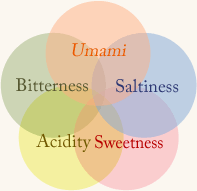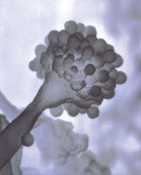
A TRINITY OF INGREDIENTS, AN ORCHESTRA OF FIVE FLAVORS

The unique flavor of soy sauce has savory umami, of course, but it is created from a balance of umami, sweetness, acidity, saltiness, and bitterness. That balance is born when the constituents of the soybeans and wheat are transformed during the fermentation period into diverse flavor and aromatic components, which all act together. The harmonious flavor is the result of those five tastes working together like a quintet.

The umami of soy sauce is created when the protein in the soybeans and wheat is broken down by enzymes from the koji mold, which convert it into around 20 varieties of amino acid. Among them, glutamic acid is main element of the savory flavor.

The salt content of soy sauce is 16 to 17% in common soy sauce. That is five or six times the concentration in sea water. The fact that it does not feel as salty as all that is because constituents such as amino acids and lactic acid buffer the salty taste, to produce a flavor with more depth.

The sweetness of soy sauce is created when the starch in wheat is converted to glucose during fermentation. It softens the overall taste, making it more rounded. When tasted, it gives a subtle sensation of sweetness at the tip of the tongue.

The acidity of soy sauce is created when lactic acid bacteria converts the glucose. The organic acids produced in this way soften the saltiness and tighten the taste.

There are a number of bitter constituents in soy sauce. That bitterness is never felt directly, but it is present as a hidden flavor that lends depth to the whole, making it clear and coherent.
THREE TYPES OF MICROORGANISM DELIVER A DELICIOUS TASTE

The flavor of soy sauce is created by three types of microorganism during the fermentation process. First, the koji mold produces a variety of enzymes which break down the raw materials, making soybean protein into peptides and amino acids, and wheat starch into glucose. The basic constituents made in this way are converted again by lactic acid bacteria into other constituents, such as lactic and acetic acids. These lend depth to the flavor of soy sauce. The last microorganism to play its part is yeast, which makes sugars and amino acids into alcohol and a range of aromatics. That is how the true flavor of soy sauce is generated. This process completes the characteristic color, flavor, and fragrance of soy sauce. The secret of why so many people love soy sauce is here.
SOY SAUCE IS A TREASURE CHEST OF FRAGRANCES! THERE ARE AROUND 300 AROMATIC CONSTITUENTS!
The fragrance of soy sauce is created by microorganisms such as koji mold, yeast, and lactic acid bacteria. Over 300 types of aromatic constituent have been discovered in honjozo soy sauce so far. They generate the unique and harmonious overall fragrance of soy sauce, in which no individual scent is too prominent. That fragrance has a spicing action that eliminates the odors of seafood and meat, and generate a spicy scent when heated.